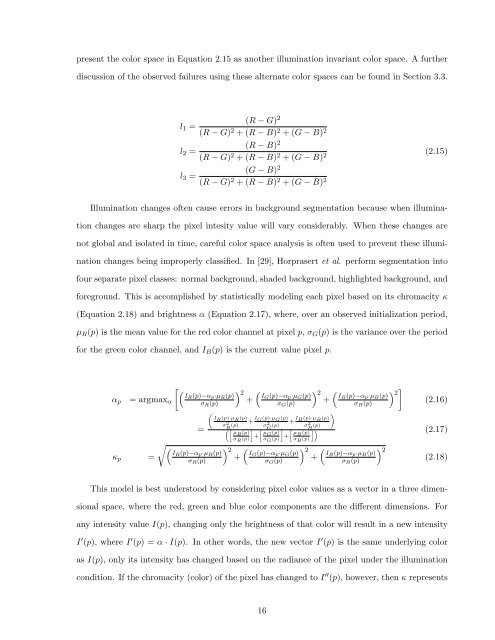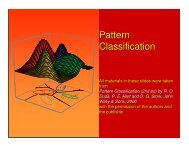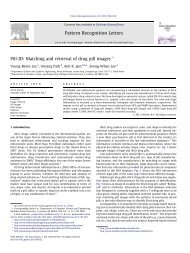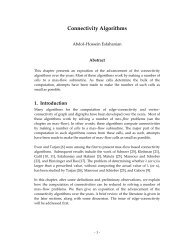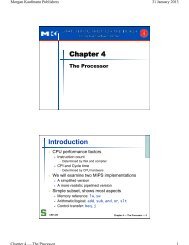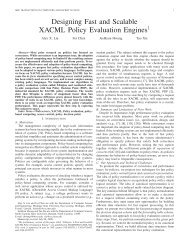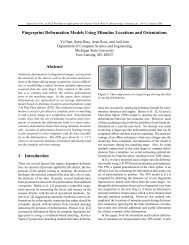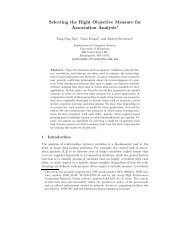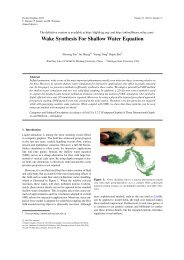Background Subtraction Using Ensembles of Classifiers with an ...
Background Subtraction Using Ensembles of Classifiers with an ...
Background Subtraction Using Ensembles of Classifiers with an ...
You also want an ePaper? Increase the reach of your titles
YUMPU automatically turns print PDFs into web optimized ePapers that Google loves.
present the color space in Equation 2.15 as <strong>an</strong>other illumination invari<strong>an</strong>t color space. A furtherdiscussion <strong>of</strong> the observed failures using these alternate color spaces c<strong>an</strong> be found in Section 3.3.l 1 =l 2 =l 3 =(R − G) 2(R − G) 2 + (R − B) 2 + (G − B) 2(R − B) 2(R − G) 2 + (R − B) 2 + (G − B) 2 (2.15)(G − B) 2(R − G) 2 + (R − B) 2 + (G − B) 2Illumination ch<strong>an</strong>ges <strong>of</strong>ten cause errors in background segmentation because when illuminationch<strong>an</strong>ges are sharp the pixel intesity value will vary considerably. When these ch<strong>an</strong>ges arenot global <strong>an</strong>d isolated in time, careful color space <strong>an</strong>alysis is <strong>of</strong>ten used to prevent these illuminationch<strong>an</strong>ges being improperly classified. In [29], Horprasert et al. perform segmentation int<strong>of</strong>our separate pixel classes: normal background, shaded background, highlighted background, <strong>an</strong>dforeground. This is accomplished by statistically modeling each pixel based on its chromacity κ(Equation 2.18) <strong>an</strong>d brightness α (Equation 2.17), where, over <strong>an</strong> observed initialization period,µ R (p) is the me<strong>an</strong> value for the red color ch<strong>an</strong>nel at pixel p, σ G (p) is the vari<strong>an</strong>ce over the periodfor the green color ch<strong>an</strong>nel, <strong>an</strong>d I B (p) is the current value pixel p.α p= argmax α[ (IR (p)−α p·µ R (p)) 2+(IG (p)−α p·µ G (p)σ G (p)σ R (p)()I R (p)·µ R (p)σR 2 + I G (p)·µ G (p)(p)σG 2 + I B (p)·µ B (p)(p)σ([ ] [ ] [ B 2 (p)µR (p) µG (p) µB (p)+ +σ R (p) σ G (p) σ B (p)=) 2 ( ) ]IB (p)−α + p·µ B (p) 2σ B (p)(2.16)]) (2.17)κ p =√ (IR (p)−α p·µ R (p)σ R (p)) 2+(IG (p)−α p·µ G (p)σ G (p)) 2+(IB (p)−α p·µ B (p)σ B (p)) 2(2.18)This model is best understood by considering pixel color values as a vector in a three dimensionalspace, where the red, green <strong>an</strong>d blue color components are the different dimensions. For<strong>an</strong>y intensity value I(p), ch<strong>an</strong>ging only the brightness <strong>of</strong> that color will result in a new intensityI ′ (p), where I ′ (p) = α · I(p). In other words, the new vector I ′ (p) is the same underlying coloras I(p), only its intensity has ch<strong>an</strong>ged based on the radi<strong>an</strong>ce <strong>of</strong> the pixel under the illuminationcondition. If the chromacity (color) <strong>of</strong> the pixel has ch<strong>an</strong>ged to I ′′ (p), however, then κ represents16


